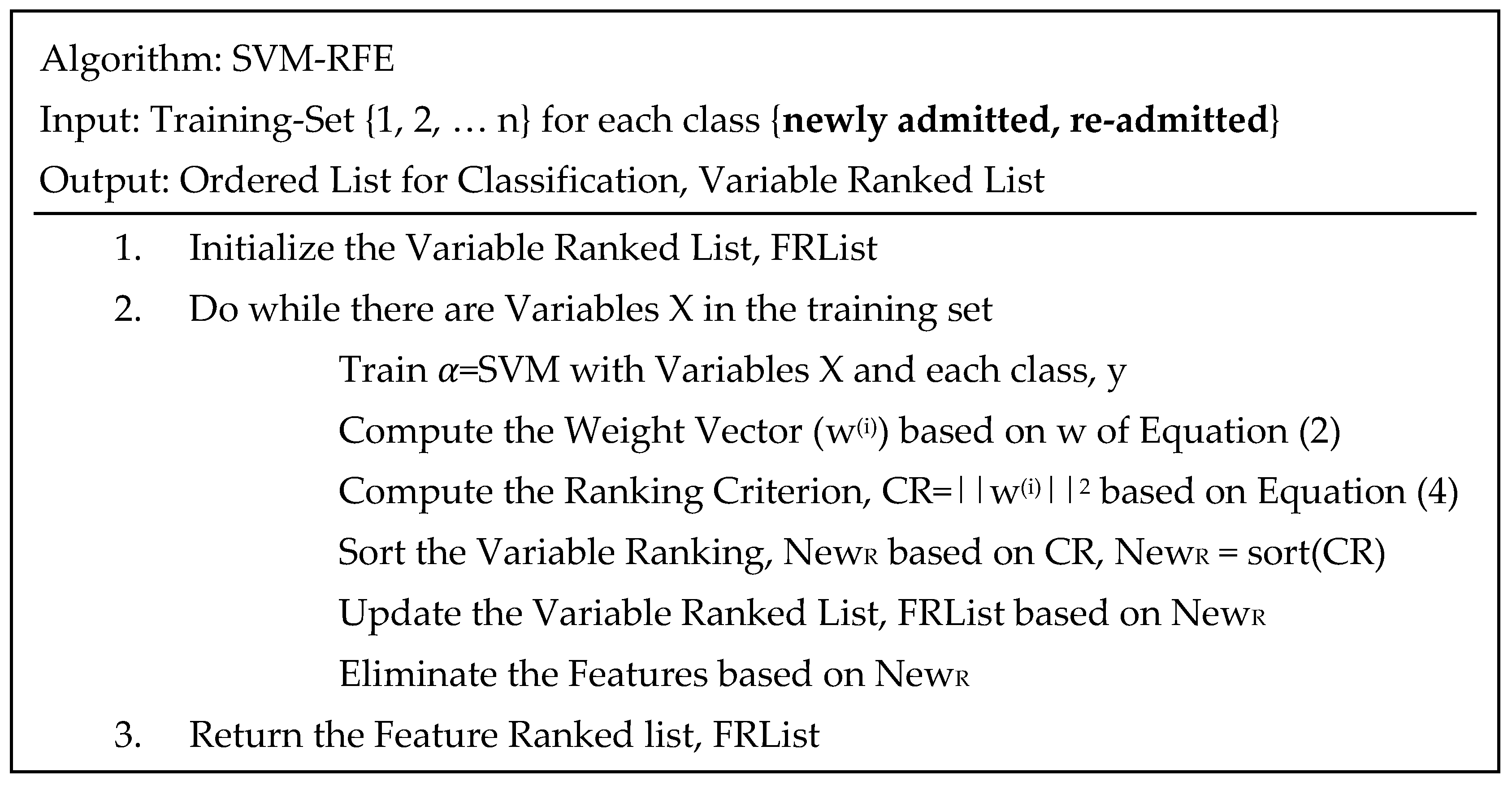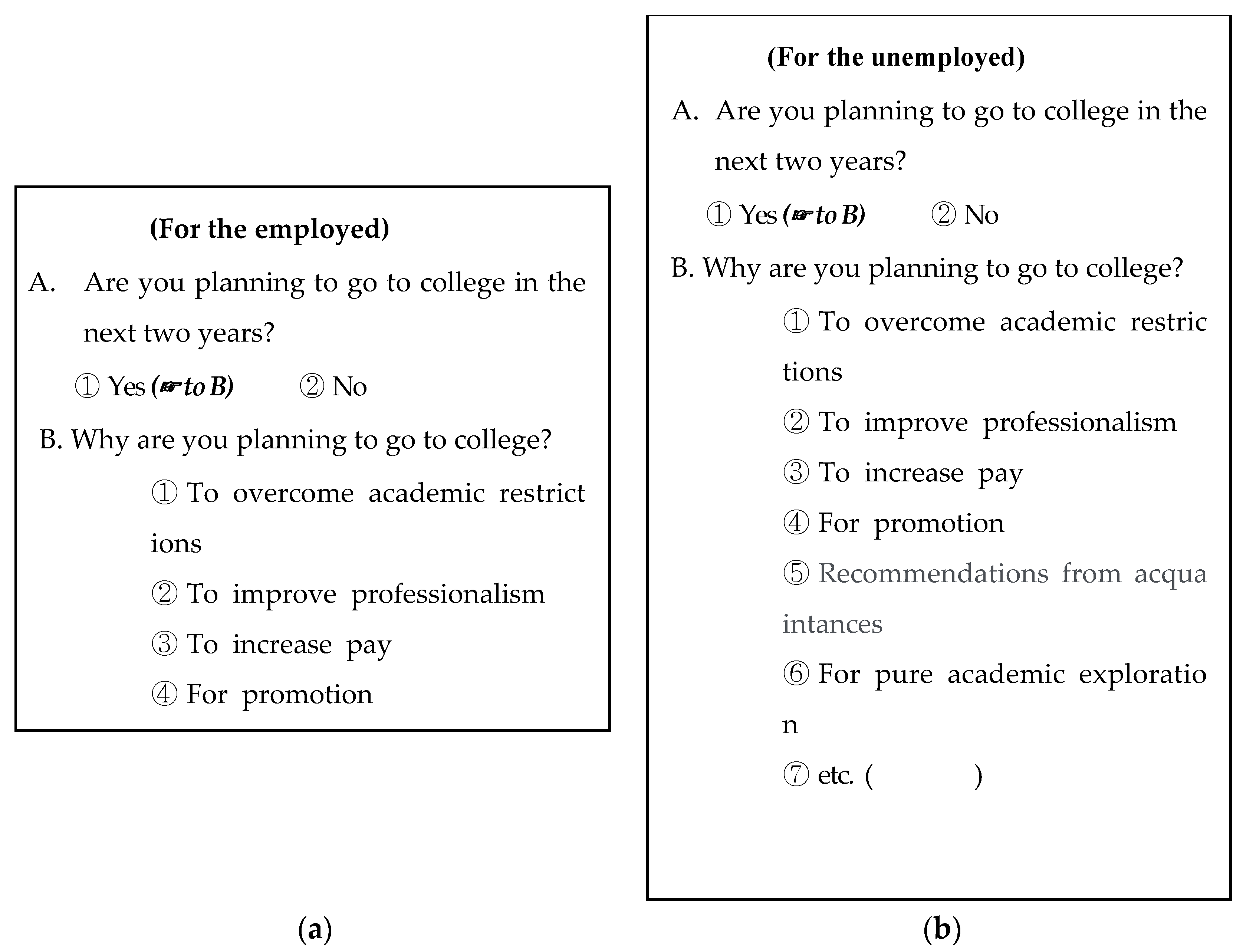Predicting the Variables That Determine University (Re-)Entrance as a Career Development Using Support Vector Machines with Recursive Feature Elimination: The Case of South Korea
Abstract
1. Introduction
2. Theoretical Background
2.1. University (Re-)Entrance as Career Development of Korean High-School Graduates
2.2. Career Development from an Ecological Perspective
2.3. SVM-RFE in Educational Fields
- (1)
- Survival analysis (time-to-event analysis): Once you have a model through survival analysis on your data, you can answer the following questions.
- What is the probability that a patient diagnosed with blood cancer will survive for more than 3 years?
- −
- Survival probability S(t)
- How long should I wait to catch a taxi?
- −
- Median t time
- I have 100 job seekers. How many people get a job after one year?
- −
- 100 × S(t) persons
- (1)
- Survival analysis applications: Survival analysis applications are frequently used in the following medicines, but the same technique can be used in marketing and engineering (reliability).
- Establishing a business plan
- −
- Establishing a strategy by identifying the characteristics of customers with a long remaining period without departure
- Lifetime Value (LTV) Forecast
- −
- Responding to customers in line with LTV values
- Effective customers
- −
- Predict whether customers will be valid until a certain point in time
- Campaign evaluation
- −
- Monitoring campaign effectiveness according to customer churn rate (survival rate)
- Industry-specific survival analysis
- −
- Retail: The time it takes for customers to purchase fresh food to purchase non-fresh food
- −
- Manufacturing: Machine parts lifetime
- −
- Public: The time it takes for an important social event to occur
- −
- Catalog mail order: time to next order
- −
- Home mortgage: the time it takes to repay your home mortgage
- −
- Insurance: Time to extinguish insurance policy rights
3. Methods
4. Evaluation Results
5. Discussion and Conclusions
Author Contributions
Funding
Acknowledgments
Conflicts of Interest
References
- Jung, J. The Exploratory Study on Career Choice and Career decision-making of University Students in Seoul. CNU J. Educ. Stud. 2018, 39, 123–147. [Google Scholar] [CrossRef]
- Asabere, N.Y.; Amoako, E. Improving Career Decision-Making for High School Students through a Web-Based Expert System: Field Testing in Ghana. Int. J. ICT Res. Afr. Middle East (IJICTRAME) 2020, 9. [Google Scholar] [CrossRef]
- Germeijs, V.; Verschueren, K. High school students’ career decision-making process: Consequences for choice implementation in higher education. J. Vocat. Behav. 2007, 70, 223–241. [Google Scholar] [CrossRef]
- Chopra, P. Teachers’ participation in school decision-making processes and practices: The case of an Indian government secondary school. Ital. J. Sociol. Educ. 2020, 12, 44–55. [Google Scholar] [CrossRef]
- Hong, J.L.; Chang, N.K. Analysis of Korean high school students’ decision-making processes in solving a problem involving biological knowledge. Res. Sci. Educ. 2004, 34, 97–111. [Google Scholar] [CrossRef]
- Bronfenbrenner, U. The Ecology of Human Development; Harvard University Press: Cambridge, MA, USA, 1979. [Google Scholar]
- Bronfenbrenner, U. Ecology of the family as a context for human development: Research perspectives. Dev. Psychol. 1986, 22, 723–742. [Google Scholar] [CrossRef]
- Bronfenbrenner, U. Developmental ecology throrgh space and time: A future perspective. In Examining Lives in Context: Perspectives on the Ecology of Human Development; Moen, P., Elder, G.H., Luscher, K., Eds.; American Psychological Association: Washington, DC, USA, 1995; pp. 619–647. [Google Scholar]
- Mashige, K.P.; Oduntan, O.A. Factors influencing South African optometry students in choosing their career and institution of learning. Afr. Vis. Eye Health 2011, 70, 21–28. [Google Scholar] [CrossRef]
- Bandura, A.; Barbaranelli, C.; Caprara, G.V.; Pastorelli, C. Self-efficiency beliefs as shapers of children’s aspirations and trajectories. Child Dev. 2001, 72, 187–206. [Google Scholar] [CrossRef]
- Bryant, B.K.; Zvonkovic, A.M.; Reynolds, P. Parenting in relation to children and adolescent vocational behaviours. J. Voc. Behav. 2006, 69, 149–175. [Google Scholar] [CrossRef]
- Hardigan, P.C.; Cohen, S.R. Comparison of personality styles between students enrolled in osteopathic medicine, pharmacy, physical therapy, physician assistant and occupational therapy programmes. J. Am. Osteopath Assoc. 1998, 98, 637–641. [Google Scholar]
- Lee, S.; Shouse, R.C. The impact of prestige orientation on shadow education in South Korea. Sociol. Educ. 2011, 84, 212–224. [Google Scholar] [CrossRef]
- Kwon, S.K.; Lee, M.; Shin, D. Educational assessment in the Republic of Korea: Lights and shadows of high-stake exam-based education system. Assess. Educ. Princ. Policy Pract. 2017, 24, 60–77. [Google Scholar] [CrossRef]
- Lee, J.K. Educational fever and South Korean higher education. Rev. Electrónica Investig. Educ. (REDIE) 2006, 8. Available online: http://redie.uabc.mx/vol8no1/contents-lee2.html (accessed on 6 January 2020).
- Seth, M.J. Education Fever: Society, Politics, and the Pursuit of Schooling in South Korea; University of Hawaii Press: Honolulu, HI, USA, 2002. [Google Scholar]
- Lee, S.; Brinton, M.C. Elite education and social capital: The case of South Korea. Sociol. Educ. 1996, 69, 177–192. [Google Scholar] [CrossRef]
- Tokar, D.M.; Withrow, J.R.; Hall, R.J.; Moradi, B. Psychological separation, attachment security, vocational self-concept crystallization, and career indecision: A structural equation analysis. J. Couns. Psychol. 2003, 50, 3–19. [Google Scholar] [CrossRef]
- Van Matre, G.; Cooper, S. Concurrent Evaluation of Career Indecision and Indecisiveness. Pers. Guid. J. 1984, 62, 637–639. [Google Scholar] [CrossRef]
- Santos, P.J.; Ferreira, J.A.; Goncalves, C.M. Indecisiveness and career indecision: A test of a theoretical model. J. Vocat. Behav. 2014, 85, 106–114. [Google Scholar] [CrossRef]
- Melson, G.F. Family and Environment: An Ecosystem Perspective; Burgess Press: Minneapolis, MN, USA, 1980. [Google Scholar]
- Young, R.A. Career development of adolescents: An ecological perspective. J. Youth Adolesc. 1983, 12, 401–417. [Google Scholar] [CrossRef]
- Cortes, C.; Vapnik, V. Support-vector networks. Mach. Learn. 1995, 20, 273–297. [Google Scholar] [CrossRef]
- Sanz, H.; Valim, C.; Vegas, E.; Oller, J.M.; Reverter, F. SVM-RFE: Selection and visualization of the most relevant features through non-linear kernels. BMC Bioinform. 2018, 19, 1–18. [Google Scholar] [CrossRef]
- Guyon, I.; Weston, J.; Barnhill, S.; Vapnik, V. Gene selection for cancer classification using support vector machines. Mach. Learn. 2002, 46, 389–422. [Google Scholar] [CrossRef]
- Rakotomamonjy, A. Variable Selection Using SVM-based Criteria. J. Mach. Learn. Res. 2003, 3, 1357–1370. [Google Scholar]
- Chang, W. A study on reverse transfer students in Korean junior and technical colleges. J. Vocat. Educ. Res. 2004, 23, 1–18. [Google Scholar]
- Creed, P.A.; Patton, W. Differences in career attitude and career knowledge for high school students with and without paid work experience. Int. J. Educ. Vocat. Guid. 2003, 3, 21–33. [Google Scholar] [CrossRef]
- Mortimer, J.T.; Zimmer-Gembeck, M.J.; Holmes, M.; Shanahan, M.J. The process of occupational decision making: Patterns during the transition to adulthood. J. Vocat. Behav. 2002, 61, 439–465. [Google Scholar] [CrossRef]
- Kelly, K.R.; Pulver, C.A. Refining measurement of career indecision types: A validity study. J. Couns. Dev. 2003, 81, 445–453. [Google Scholar] [CrossRef]
- Kim, K.; Lee, C.; Choi, B. A research for forecasting of rate of university quota according to the reducing of young generation. J. Korean Data Inf. Sci. Soc. 2015, 26, 1175–1188. [Google Scholar]


| System | Examples |
|---|---|
| individual systems | gender roles, religious beliefs, and intrapsychic processes |
| microsystems | family, siblings, teachers, peers, and schools where each student belongs |
| mesosystems | interaction between parents, siblings, teachers, and peers |
| exosystems | extended family, community resources, school board, organization neighborhoods, mass media, and parents’ work environments where each student belongs |
| macrosystems | social, cultural, historical influences, broad ideology, and laws and customs |
| chronosystems | changes in environment over time |
| Variable Ranking | No.1 Why Are You Preparing for the Entrance Exam again? | No. 2 If You Enter University again, Why Do You Choose Your Major? | ||||
|---|---|---|---|---|---|---|
| Re-admitted group | Class variable (Weight) | The university’s social awareness was low | 37.04 | Class variable (Weight) | My talent and aptitude | 48.15 |
| I didn’t like the former university | 25.93 | My hope | 37.04 | |||
| Parent’s recommendation | 0 | Parent’s recommendation | 0 | |||
| Newly admitted group | Class variable (Weight) | CAST score was low | 46.44 | Class variable (Weight) | My hope | 44.76 |
| Rejected by all the colleges that I applied for | 23.03 | My talent and aptitude | 41.39 | |||
| Parents’ recommendation | 0 | Parents’ recommendation | 1 | |||
| Variable | What Is the Main Reason for Preparing for College Entrance again? | |
|---|---|---|
| Re-admitted and newly admitted group | Class variable | Association with class variables mentioned in Table 2 (Weight) |
| Rejected by all the colleges that I applied for | Newly admitted Group’s Variable Ranking No.1 (23.03%) | |
| The former university’s social awareness was low | Re-admitted Group’s Variable Ranking No.1 (37.04%) | |
| CAST score was lower than expected | Newly admitted Group’s Variable Ranking No.1 (46.44%) | |
| I didn’t like my major of the former university | Re-admitted Group’s Variable Ranking No.2 (37.04%) Newly admitted Group’s Variable Ranking No.2 (41.39%) | |
| Parent’s recommendation | Newly admitted Group’s Variable Ranking No.1 (6%) Newly admitted Group’s Variable Ranking No.2 (1%) | |
| Variable | What Is the Main Reason for Preparing for College Entrance? | |
|---|---|---|
| Both the employed and unemployed | Class variable | Association with class variables mentioned in Table 2 (Weight) |
| To overcome academic restrictions | Re-admitted Group’s Feature Ranking No.1 The prior university’s recognition was low (37.04%) | |
| To improve professionalism | Re-admitted Group’s Feature Ranking No.2 My talent and aptitude (48.15%) Newly Admitted Group’s Feature Ranking No.2 My talent and aptitude (41.39%) | |
| To increase pay | Re-admitted Group’s Feature Ranking No.2 My talent and aptitude (48.15%) Newly Admitted Group’s Feature Ranking No.2 My talent and aptitude (41.39%) | |
| For promotion | Re-admitted Group’s Feature Ranking No.2 My talent and aptitude (48.15%) Newly Admitted Group’s Feature Ranking No.2 My talent and aptitude (41.39%) | |
| Only the unemployed | Recommendations from acquaintances | Newly Admitted Group’s Feature Ranking No.1 Parents’ recommendation (6%) Newly Admitted Group’s Feature Ranking No.2 Parents’ recommendation (1%) |
| For pure academic exploration | Re-admitted Group’s Feature Ranking No.2 My hope (37.04%) Newly Admitted Group’s Feature Ranking No.2 My hope (44.76%) | |
© 2020 by the authors. Licensee MDPI, Basel, Switzerland. This article is an open access article distributed under the terms and conditions of the Creative Commons Attribution (CC BY) license (http://creativecommons.org/licenses/by/4.0/).
Share and Cite
Park, T.; Kim, C. Predicting the Variables That Determine University (Re-)Entrance as a Career Development Using Support Vector Machines with Recursive Feature Elimination: The Case of South Korea. Sustainability 2020, 12, 7365. https://doi.org/10.3390/su12187365
Park T, Kim C. Predicting the Variables That Determine University (Re-)Entrance as a Career Development Using Support Vector Machines with Recursive Feature Elimination: The Case of South Korea. Sustainability. 2020; 12(18):7365. https://doi.org/10.3390/su12187365
Chicago/Turabian StylePark, Taejung, and Chayoung Kim. 2020. "Predicting the Variables That Determine University (Re-)Entrance as a Career Development Using Support Vector Machines with Recursive Feature Elimination: The Case of South Korea" Sustainability 12, no. 18: 7365. https://doi.org/10.3390/su12187365
APA StylePark, T., & Kim, C. (2020). Predicting the Variables That Determine University (Re-)Entrance as a Career Development Using Support Vector Machines with Recursive Feature Elimination: The Case of South Korea. Sustainability, 12(18), 7365. https://doi.org/10.3390/su12187365






